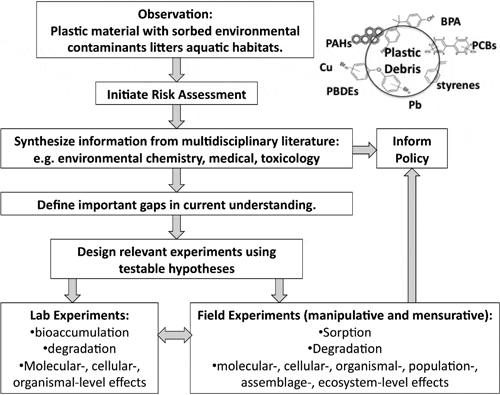Last year, 150 tons of plastic pellets spilled off the coast of Hong Kong. The BBC reported, “the plastic balls are not toxic on their own, but could absorb toxins that would be lethal to any species that might be tempted to eat them.” This highlights a common misperception regarding small plastic debris in aquatic habitats the material itself is not considered a hazard to aquatic animals. What are considered a hazard are the priority pollutants (e.g., persistent organic pollutants (POPs) and metals) that sorb to plastic debris from ambient water. Here, I argue that this viewpoint is myopic and fails to acknowledge previous research that demonstrates how plastic itself can cause harm. Small plastic particles are hazardous and in addition they sorb hazardous chemicals.1 Thus, aquatic plastic debris is unique to other materials that accumulate priority pollutants, like sediments and algae, because of the combination of plastic with sorbed chemicals. This “cocktail of contaminants” may cause effects beyond those caused from each contaminant alone. To fully understand hazards from plastic debris in aquatic habitats, it is necessary to alter our perception regarding direct and indirect threats associated with aquatic plastic debris and shift the focus of scientific research toward understanding how plastic debris and associated chemicals may act as a multiple stressor in aquatic habitats.
Current Viewpoint
Large items of aquatic plastic debris are recognized as a physical hazard through several mechanisms including entanglement, ingestion, and smothering. Hazards associated with small aquatic plastic debris are less recognized. Current research regarding small plastic debris often focuses on the priority pollutants that sorb to this material from ambient water. For example, the relationship between plastic debris and sorbed priority pollutants is established globally and there is concern that these chemicals may transfer to organisms upon ingestion and produce adverse health effects. While this concern is valid and must be further researched, a sole focus on this aspect removes the spotlight from the plastic debris itself, placing our full attention on the sorbed priority pollutants. Seen from this perspective, a piece of small plastic debris does not differ from sediment or algae.
Hazards of Plastic Materials
Small plastic debris is hazardous through processes other than environmental sorption of chemicals. Several plastics are composed of hazardous monomers (e.g., styrene, polyvinyl chloride (PVC), bisphenol-A) and chemical additives (e.g., phthalates, nonylphenol). In fact, greater than 50% of polymers produced are made from monomers that are considered hazardous based on the UN Globally Harmonized System.4 Still, polymers are considered inert due to their molecular size, although some polymers shed carcinogenic and estrogenic monomers (during production, use, disposal, or ingestion) that can transfer into the tissue of organisms. Polymerization reactions during production are rarely complete leaving unreacted residual monomers, low molecular weight polymers (e.g., styrene, PVC) and other polymerization impurities such as solvents (e.g., benzene, cyclohexane) and additives (e.g., phthalates, tributyltin) free to migrate from the material to other contact media.4 Furthermore, small plastic fragments themselves can bioaccumulate in the cells and tissues of invertebrates and vertebrates. Laboratory research demonstrates that small plastic particles ingested by mussels can translocate from the gut to their circulatory system and medical research has shown that, in rats, inhalation of these particles may compromise immune systems and cause persistent inflammation. Thus, plastics do not necessarily enter aquatic habitats inert, and hazards associated with the material itself must be acknowledged in combination with sorbed priority pollutants when considering the risks of plastic debris to aquatic life.
Future Directions
Effects from small plastic debris and sorbed chemicals may not be additive and future research is needed to identify the nature of the risks from this combination of stressors. It is likely that the risk to an organism will vary by type and size of plastic debris, which may affect its ability to concentrate chemicals from ambient water and bioaccumulate in tissues. Risks may also vary over space and time due to the concentration of hazardous chemicals available for sorption and the length of time the debris has interacted with ambient water and sunlight. Photodegradation of plastic increases surface area, and may enable greater accumulation of hazardous chemicals. Such complexity begs the initiation of research programs and risk assessments that are ecologically relevant (Figure 1).

Research should be conducted in appropriate habitats, and at appropriate spatial and temporal scales relevant to plastic debris. Furthermore, applying an ecological framework to understand patterns over space and time will lead to a better understanding of the relationship between environmental contaminants and different types of plastic debris. To determine different “cocktails” associated with various types of plastic materials, field-measurements of environmental sorption at time scales relevant to plastic debris should be considered. To begin understanding potential toxicity to organisms, initial assessments of risk should prioritize polymers that sorb relatively large quantities of pollutants and/or have several hazardous chemicals associated with them from manufacturing in specific habitats where ambient pollutant concentrations are relatively large.
It is time that researchers acknowledge the bigger picture regarding aquatic plastic debris. Our current focus on contaminants that sorb to plastic debris ignores the problems directly associated with the material itself and mistakenly assumes that hazards of small plastic debris are no different than sediment ingestion. Future studies should look beyond chemical transfer and associated toxicity from sorbed contaminants and include bioaccumulation of and toxicity from the plastic itself. Exposures should include organisms that are appropriate as indicators of species likely to be affected by plastic debris. Although laboratory exposures are useful models and proxies of natural conditions, future research should supplement laboratory studies with mensurative experiments in the wild. To effectively advise managers and policy-makers, we must read across disciplines and create new knowledge that is relevant to the unique issue of this multiple stressor, plastic debris, currently accumulating in aquatic habitats.
September 2013



